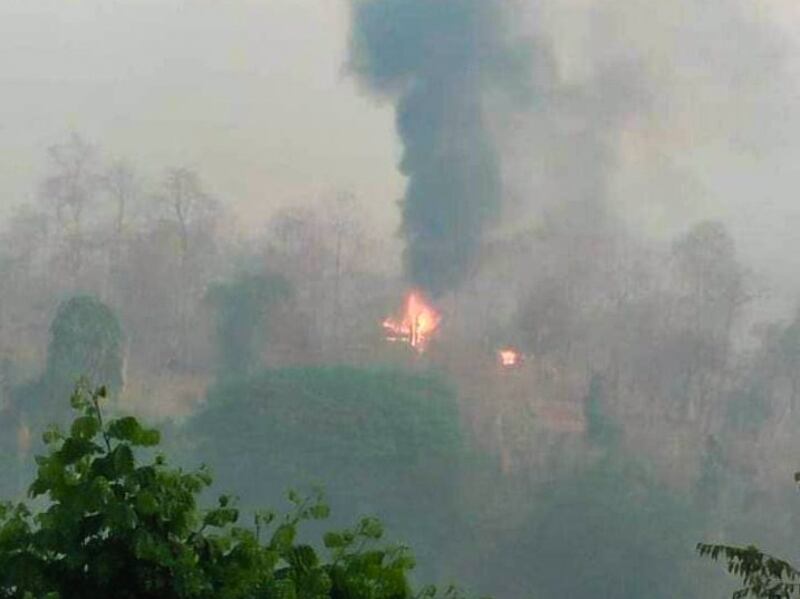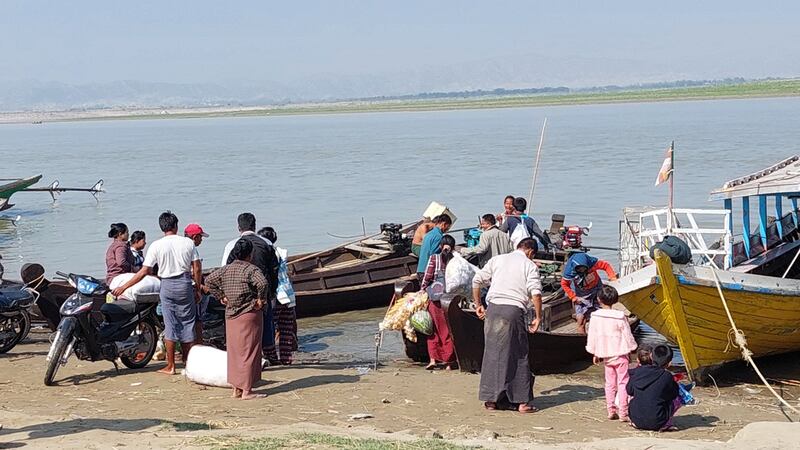Ethnic Karen rebels have attacked and seized a long-held military camp in Kayin state along Myanmar’s border with Thailand, officials with the Karen National Union said Tuesday, calling it the last of the large camps held by the junta along the key Thanlwin River.
The loss of the camp is the latest blow to the military, which launched a far-reaching offensive after taking power in a February 2021 coup d’etat, but has encountered staunch resistance from anti-junta People’s Defense Force paramilitary groups and ethnic armies in recent months, despite outclassing them in training, equipment and manpower.
The KNU’s military wing, the Karen National Liberation Army, attacked the camp in Hpapun district’s Mel Kha Hta at around 5:00 a.m. on Tuesday because of its strategic importance to the military, KNU Foreign Affairs Officer Padoh Saw Taw Nee told RFA Burmese, noting that it had a key role in supplying troops with food and other necessities.
“It can be said that the camp is the largest among those located along the Thanlwin River – that’s why it’s important,” he said. “This is the last large camp left, as most of the junta camps like this one have been shut down.”
Padoh Saw Taw Nee said that there were more than 60 junta soldiers stationed at the camp, which the military “defended vigorously” over the course of nearly two hours using small and heavy weapons.
Details of the battle had yet to be confirmed, he added.
A member of the KNLA in an area controlled by Brigade No. 5 said his group had killed at least 10 junta soldiers and seized military equipment in the clash. Two KNLA soldiers were injured in the fighting.
The KNLA set fire to all of the buildings in the military camp, he added, and the two sides are continuing to monitor one another.
Large camp housed dozens of soldiers
A Myanmar refugee sheltering in Thailand across the Thanlwin River from the Mel Kha Hta camp told RFA that he saw smoke billowing above the area for about an hour after the battle.
“I think the camp was set on fire around 7:00 in the morning,” he said. “As the smoke continued to rise, I saw that their camp had been captured, but I couldn't see any junta soldiers running away.”
The refugee confirmed that the camp “is a big one” and said junta soldiers who had fled when the KNLA recently captured the nearby Thaw Le Hta military camp were sheltering there.

A source who lives in the vicinity of the camp said he saw two Mi-35 military helicopters circling the area at around noon on Tuesday. He said that by the afternoon, no one remained at the camp.
Other residents of the area told RFA that before the camp was seized, the KNLA had warned the junta soldiers stationed there to join the nationwide Civil Disobedience Movement that has seen tens of thousands of government employees leave their jobs in protest of military rule.
The military had yet to make any announcements regarding the capture of the camp as of the time of publishing.
Saw Khin Maung Myint, the economic minister and junta spokesman for Kayin state, told RFA that he had heard the camp was seized, but was unable to provide any details.
Nearly 1,000 villagers from areas near the Mel Kha Hta camp fled to safety on Tuesday out of fear that the junta might use airstrikes to retaliate against the rebels, residents told RFA.
According to the KNU News and Information Department, more than 8,000 clashes have taken place in the areas controlled by the KNU during the two years of military rule.
Thousands flee Magway offensive
Reports of the border clash came as RFA learned that thousands of residents of Magway region’s Pakokku township have been forced to flee their homes since the beginning of a military offensive in the area on Feb. 11.
Residents said that around 300 junta soldiers have been stationed in the Myit Chay-Kyun area’s historic Tant Kyi Taung Pagoda, a power plant, a pharmaceutical factory and Let Pan Chaung village since the start of the offensive.
They said that over the last six weeks, the soldiers have been raiding and firing heavy artillery at 15 nearby villages located at the foot of Tantkyitaung Mountain and across the Ayeyarwaddy River from the ancient city of Bagan.
A resident of Aing Gyi, one of the villages that came under attack, said that not only have civilians had to flee the military offensives, but also have nowhere to shelter due to junta travel restrictions.
“Some of us could not bring our national registration cards when we had to run and now can’t go to other cities, as we need the card to do so,” said the resident who, like other sources RFA spoke with, declined to be named citing security concerns.
“That’s why we have nowhere to stay but here in this open area and are forced to run in the opposite direction any time the junta troops come.”
The resident said that junta troops have also cut off their access to food, water, and electricity.

Aing Gyi’s entire population of around 3,000 people have been constantly on the run for the 10 days since the raid on their village, he said.
Other residents who fled the 15 villages told RFA they are only able to eat one meal a day and that children and the elderly are “in desperate need of medicine.”
Raids increased in March
A resident of Let Pan Chaung village said the displaced are concerned about the approaching rainy season as they have no stable place to shelter.
The resident said that the military arrested five people from his village in March. While two have been released, junta troops “are torturing a 17-year-old and two men in their 50s” for information about the area’s armed resistance.
Some 2,000 people – nearly the entire population of Let Pan Chaung – are on the run while the military remains stationed at the village, he added.
Other residents said that the raids had become even more regular since March 5, when the anti-junta People’s Defense Force paramilitary group used landmines to attack junta troops entering Myo Soe village – another of the 15 tracts that have come under attack since Feb. 11.
The number of homes in each of the 15 villages varies from 200 to 600, and while sources told RFA that “many residents” had been arrested during the raids, the exact number remains unclear.
Attempts by RFA to contact junta Deputy Information Minister Maj. Gen. Zaw Min Tun about the raids in Pakokku township went unanswered Tuesday, as did inquiries to the military press team.
Junta chief Senior Gen. Min Aung Hlaing has said that Myanmar’s military does not destroy civilian villages, but RFA reporting suggests otherwise. Sources regularly relate stories of soldiers engaging in looting, arson, torture and killing during the raids as part of a scorched earth offensive by the military.
According to the latest situation reports published by the United Nations Office for the Coordination of Humanitarian Affairs on March 4 and March 21, the number of war refugees in Myanmar increased by more than 100,000 throughout the country in the two weeks from Feb. 27 to March 13 alone.
The latest additions – most of whom live in Kachin, Kayah, and Shan states, as well as eastern Bago region – bring the number of those displaced by conflict in the country to more than 1.7 million people, UNOCHA said.
Translated by Myo Min Aung. Edited by Joshua Lipes and Malcolm Foster.
